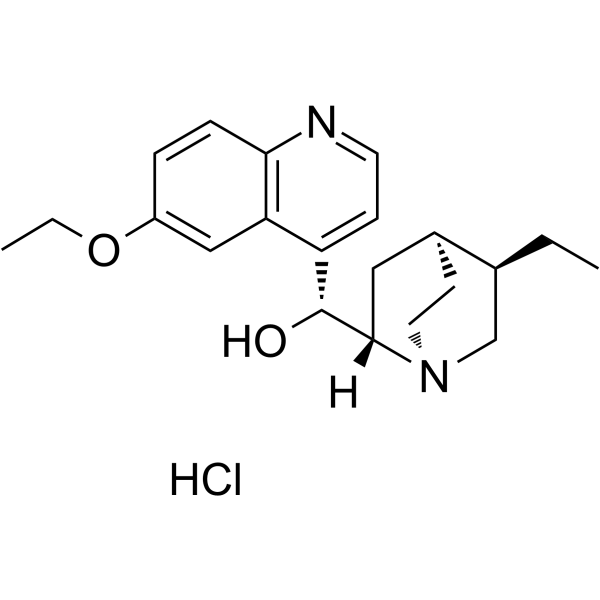Ethylhydrocupreine hydrochloride |
| Catalog No.GC63580 |
El clorhidrato de etilhidrocupreÍna (clorhidrato de optoquina) es un derivado de la quinina con actividad antimicrobiana contra S.
Products are for research use only. Not for human use. We do not sell to patients.

Cas No.: 3413-58-9
Sample solution is provided at 25 µL, 10mM.
Ethylhydrocupreine hydrochloride (Optochin hydrochloride) is a quinine derivate with antimicrobial activity against S. pneumoniae. Ethylhydrocupreine hydrochloride also possesses antimalarial activity against Plasmodium falciparum, with an IC50 of 25.75 nM. Ethylhydrocupreine hydrochloride is a Gallus gallus taste 2 receptors (ggTas2r1, ggTas2r2 and ggTas2r7) agonist[1][2][3][4].
The mutation rate to Ethylhydrocupreine (Optochin) resistance is estimated using fluctuation analysis in three capsulated S. pneumoniae strains (S. pneumoniae D39 NCTC 7466, S. pneumoniae R6 ATCC BAA-255 and S. pneumoniae ATCC 49619). The exposure to subinhibitory concentrations of penicillin increased the mutation rate (expressed as mutation per cell division) to Ethylhydrocupreine (Optochin) resistance between 2.1- and 3.1-fold for all three strains studied[2].
The injection of 1 cc. of a 24 hour dextrose blood broth culture of virulent Type I pneumococci into the right pleural cavity of guinea pigs produces acute suppurative pleuritis on both sides associated with suppurative pericarditis. The injection of 1 cc. of 1:500 solutions of Ethylhydrocupreine hydrochloride into each pleural cavity of guinea pigs at varying intervals up to 24 hours after pleural infection has usually shown a marked curative influence. Similar results are observed with dogs[1].
[1]. J A Kolmer, et al. CHEMOTHERAPEUTIC STUDIES WITH ETHYLHYDROCUPREINE HYDROCHLORIDE IN EXPERIMENTAL PNEUMOCOCCUS PLEURITIS. J Exp Med. 1921 May 31;33(6):693-711.
[2]. Paulo R Cortes, et al. Subinhibitory Concentrations of Penicillin Increase the Mutation Rate to Optochin Resistance in Streptococcus Pneumoniae. J Antimicrob Chemother. 2008 Nov;62(5):973-7.
[3]. Nassira Mahmoudi, et al. Identification of New Antimalarial Drugs by Linear Discriminant Analysis and Topological Virtual Screening. J Antimicrob Chemother. 2006 Mar;57(3):489-97.
[4]. Antonella Di Pizio, et al. Molecular Features Underlying Selectivity in Chicken Bitter Taste Receptors. Front Mol Biosci. 2018 Jan 31;5:6.
Average Rating: 5 (Based on Reviews and 5 reference(s) in Google Scholar.)
GLPBIO products are for RESEARCH USE ONLY. Please make sure your review or question is research based.
Required fields are marked with *




















